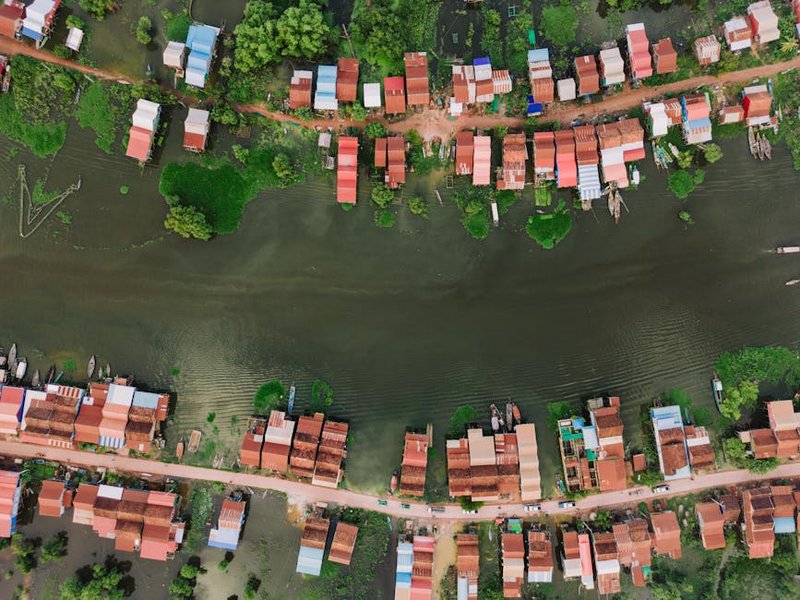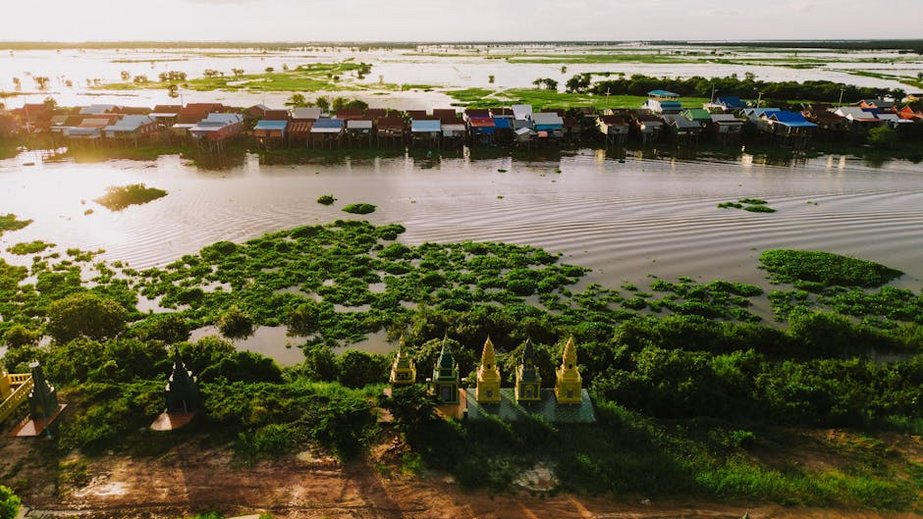Cambodia Tonle Sap Floating Villages: Discover Water-Based Living
Cambodia Tonle Sap Floating Villages offer a unique glimpse into aquatic communities thriving on Southeast Asia’s largest freshwater lake, where homes, schools, and markets float atop seasonal waters. This remarkable ecosystem supports thousands of residents who adapt their entire lifestyles to the lake’s dramatic wet and dry season fluctuations between June and November. Your visit provides cultural immersion through boat tours, local cuisine, and insights into sustainable living practices that have evolved over generations.
Essential Tonle Sap Lake Information
Tonle Sap Lake expands from 2,500 square kilometers in the dry season to over 16,000 square kilometers during monsoon rains, creating the world’s most productive inland fisheries. This UNESCO Biosphere Reserve shelters endangered bird species like the Bengal florican and supports over 1.2 million people through fishing and agriculture. Local communities have developed specialized architectural techniques for building floating structures that rise and fall with water levels.
Geography and Seasonal Dynamics
The lake’s unique hydrology reverses flow direction annually, with the Tonle Sap River feeding into the Mekong during dry months then reversing when monsoon rains arrive. Water levels can fluctuate up to 10 meters between seasons, completely transforming the landscape and accessibility. These dramatic changes directly impact village locations, transportation routes, and daily life patterns for residents.
Historical Development Timeline
Floating settlements emerged centuries ago as fishing communities recognized the lake’s abundant resources and protection from land-based conflicts. French colonial records from the 19th century document established villages with distinct cultural practices adapted to aquatic environments. Modern development has introduced solar power and improved boat transportation while maintaining traditional architectural styles.
- Pre-Angkorian Era (500-800 CE): Early evidence of lake-based settlements with archaeological finds of fishing tools and boat remnants near current village sites.
- Colonial Period (1863-1953): French explorers documented sophisticated floating communities with specialized house designs and seasonal migration patterns.
- Modern Development (1990s-Present): Infrastructure improvements including floating schools, health centers, and solar power systems enhanced living conditions.
- Budget tours ($15-25) utilize shared longtail boats with basic commentary, visiting one village with minimal interaction opportunities and lasting 2-3 hours from Siem Reap departure points.
- Mid-range options ($30-50) feature smaller group sizes, English-speaking guides, multiple village stops including floating markets, and sometimes include simple lunch meals with local families.
- Premium experiences ($60-100) provide private boat transportation, specialized photography guides, authentic meal preparations in village homes, and visits to less-accessible communities with unique cultural demonstrations.
- Cambodia Ministry of Tourism
- UNESCO Tonle Sap Biosphere Reserve
Cultural Significance and Traditions
Water-based lifestyles have shaped distinctive cultural practices, including floating wedding ceremonies and water festival celebrations that honor the river’s life-giving properties. Families typically live in multi-generational household clusters, with elders teaching children fishing techniques and boat handling from early ages. Religious practices blend Buddhism with animist beliefs centered on water spirits and natural elements.
Cambodia Tonle Sap Floating Villages – Planning Your Trip
Visiting these remarkable aquatic communities requires understanding seasonal accessibility, with boat tours operating year-round but offering different experiences during high and low water periods. Budget approximately $35-75 per person for a full-day tour including transportation, guide services, and village entrance fees from Siem Reap. Your Cambodia Tonle Sap Floating Villages itinerary should include multiple village types to appreciate the diversity of water-based lifestyles and architectural adaptations.
Best Time to Visit Floating Villages
Peak season occurs between November and February when water levels remain high enough for boat access but temperatures range from 75-85°F (24-29°C) with lower humidity. These months provide optimal photography conditions with dramatic landscapes and vibrant community activities. Shoulder seasons in March-May and September-October offer fewer crowds but higher temperatures reaching 95°F (35°C) with occasional rainfall.
Budget Planning and Costs
Tour prices vary significantly based on group size, boat type, and included amenities, with basic options starting at $15 per person.
Essential Preparation Checklist
Pack lightweight quick-dry clothing, waterproof bags for electronics, and sturdy shoes with grip for potentially slippery boat transfers between structures. Bring sufficient Cambodian Riel or US dollars in small denominations since ATMs don’t exist in floating communities and credit cards remain unusable. Book tours at least 2-3 days ahead during peak season through reputable operators in Siem Reap who employ local guides from the villages themselves.

Alt: “tonle-sap-floating-village-stilt-houses-water-reflection”
Top Attractions and Village Experiences
Different floating communities showcase varied architectural styles and economic activities, from fishing-focused Kampong Phluk to tourist-adapted Chong Kneas near Siem Reap. Morning tours typically encounter more active daily life with children traveling to school boats and fishermen returning with overnight catches. Combining village visits with bird sanctuary stops and floating forest exploration provides comprehensive understanding of this unique ecosystem.
Must-See Floating Communities
Kampong Phluk features remarkable stilted houses rising 10 meters above dry season ground level, with residents using ladders to access their homes during low water months between February and May. This village maintains strong fishing traditions and offers authentic glimpses into daily life without excessive commercial tourism infrastructure. Visitors can observe fish processing techniques and traditional boat building workshops.
Chong Kneas serves as the most accessible floating settlement located just 15 kilometers from Siem Reap, featuring floating schools, basketball courts, and markets that adapt to water level changes. While more commercialized than other villages, it provides excellent infrastructure for visitors including proper docking facilities and organized cultural demonstrations. The nearby Gecko Environment Center offers educational exhibits about lake ecology.
Boat Tour Variations and Activities
Standard group tours utilize covered longtail boats seating 8-12 passengers with basic sun protection and safety equipment, typically lasting 3-4 hours with multiple stops. Private photography tours often use smaller, faster boats that access narrow channels and provide flexibility for optimal lighting conditions during golden hour. Some operators offer sunset tours that include floating restaurant dinners with spectacular views over the lake.
Wildlife and Ecological Highlights
Prek Toal Bird Sanctuary located at the lake’s northwest corner shelters endangered species like spot-billed pelicans and greater adjutant storks between December and April. The flooded forest surrounding Kampong Phluk creates mesmerizing landscapes with tree roots submerged in clear waters, particularly photogenic during early morning hours. Fishing demonstrations showcase traditional techniques using bamboo traps and circular throw nets.
Practical Travel Information
Transportation primarily originates from Siem Reap, with tuk-tuk transfers to boat docks costing $5-15 depending on distance and negotiation skills. Accommodation options range from basic guesthouses in nearby terrestrial villages to luxury hotels in Siem Reap, though overnight stays in floating communities remain limited to specialized homestay programs. Advance booking proves essential during November-February when visitor numbers peak.
| Category | Options/Features | Price Range (USD) |
|---|---|---|
| Boat Tours | Shared longtail, private speedboat, photography specialty | $15-100 |
| Accommodation | Siem Reap hotels, riverside guesthouses, homestays | $20-200 |
| Transportation | Tuk-tuk transfers, private car, bicycle rental | $5-40 |
| Food & Drinks | Vendor snacks, restaurant meals, bottled water | $3-25 |


